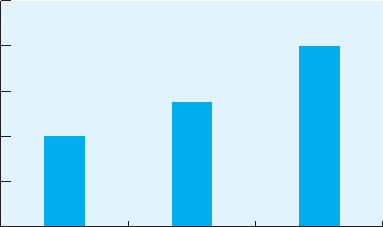Jackson S.L. Research Methods and Statistics: A Critical Thinking Approach
Подождите немного. Документ загружается.


262
■ ■
CHAPTER 10
Kruskal-Wallis analysis of variance) and for designs in which nominal data
are collected (the chi-square test).
Between-Participants Designs:
One-Way
Randomized ANOVA
We will begin our coverage of statistics appropriate for multiple-group
designs by discussing those used with data collected from a between-
participants design. Recall that a between-participants design is one in
which different participants serve in each condition. Imagine that we con-
ducted the experiment mentioned at the beginning of the chapter in which
participants are asked to study a list of 10 words using rote rehearsal or one
of two forms of elaborative rehearsal. A total of 24 participants are randomly
assigned, 8 to each condition. Table 10.1 lists the number of words correctly
recalled by each participant.
Because these data represent an interval-ratio scale of measurement
and because there are more than two groups, an ANOVA is the appro-
priate statistical test to analyze the data. In addition, because this is a
between-participants design, we use a one-way randomized ANOVA.
The term randomized indicates that participants are randomly assigned to
conditions in a between-participants design. The term one-way indicates
that the design uses only one independent variable—in this case, type of
rehearsal. We will discuss statistical tests appropriate for correlated-groups
designs later in this chapter, and tests appropriate for designs with more
than one independent variable in the next chapter. Note that although all
of the studies used to illustrate the ANOVA procedure in this chapter have
an equal number of participants in each condition, this is not necessary to
the procedure.
one-way randomized
ANOVA An inferential
statistical test for comparing the
means of three or more groups
using a between-participants
design and one independent
variable.
one-way randomized
ANOVA An inferential
statistical test for comparing the
means of three or more groups
using a between-participants
design and one independent
variable.
TABLE 10.1 Numbers of Words Recalled Correctly in Rote Rehearsal,
Imagery, and Story Conditions
ROTE REHEARSAL IMAGERY STORY
2 4 6
4 5 5
3 7 9
5 6 10
2 5 8
7 4 7
6 8 10
3 5 9
X 4
X 5.5
X 8 Grand mean 5.833
10017_10_ch10_p256-289.indd 262 2/1/08 1:30:28 PM
Experimental Designs with More Than Two Levels of an Independent Variable
■ ■
263
One-Way Randomized ANOVA: What It Is and What It Does. The ANOVA
is a parametric inferential statistical test for comparing the means of three
or more groups. In addition to helping maintain an acceptable Type I error
rate, the ANOVA has the advantage over using multiple t tests of being more
powerful and thus less susceptible to a Type II error. In this section, we will
discuss the simplest use of ANOVA—a design with one independent vari-
able with three levels.
Let’s continue to use the experiment and data presented in Table 10.1.
Remember that we are interested in the effects of rehearsal type on memory.
The null hypothesis (H
0
) for an ANOVA is that the sample means represent
the same population (H
0
:
1
2
3
). The alternative hypothesis (H
a
) is
that they represent different populations (H
a
: at least one another ).
When a researcher rejects H
0
using an ANOVA, it means that the indepen-
dent variable affected the dependent variable to the extent that at least one
group mean differs from the others by more than would be expected based
on chance. Failing to reject H
0
indicates that the means do not differ from
each other more than would be expected based on chance. In other words,
there is not enough evidence to suggest that the sample means represent at
least two different populations.
In our example, the mean number of words recalled in the rote rehearsal
condition is 4, for the imagery condition it is 5.5, and in the story condition
it is 8. If you look at the data from each condition, you will notice that most
participants in each condition did not score exactly at the mean for that
condition. In other words, there is variability within each condition. The
grand mean—the mean performance across all participants in all conditions—
is 5.833. Because none of the participants in any condition recalled exactly
5.833 words, there is also variability between conditions. We are interested
in whether this variability is due primarily to the independent variable (dif-
ferences in rehearsal type) or to error variance—the amount of variability
among the scores caused by chance or uncontrolled variables (such as indi-
vidual differences between participants).
The error variance can be estimated by looking at the amount of vari-
ability within each condition. How will this give us an estimate of error
variance? Each participant in each condition was treated similarly; each was
instructed to rehearse the words in the same manner. Because the partici-
pants in each condition were treated in the same manner, any differences
observed in the number of words recalled are attributable only to error vari-
ance. In other words, some participants may have been more motivated, or
more distracted, or better at memory tasks—all factors that would contribute
to error variance in this case. Therefore, the within-groups variance (the
variance within each condition or group) is an estimate of the population
error variance.
Now we can compare the means between the groups. If the independent
variable (rehearsal type) had an effect, we would expect some of the group
means to differ from the grand mean. If the independent variable had no
effect on the number of words recalled, we would only expect the group
means to vary from the grand mean slightly, as a result of error variance
grand mean The mean
performance across all
participants in a study.
grand mean The mean
performance across all
participants in a study.
error variance The amount
of variability among the
scores caused by chance or
uncontrolled variables.
error variance The amount
of variability among the
scores caused by chance or
uncontrolled variables.
within-groups variance
The variance within each
condition; an estimate of the
population error variance.
within-groups variance
The variance within each
condition; an estimate of the
population error variance.
10017_10_ch10_p256-289.indd 263 2/1/08 1:30:29 PM
264
■ ■
CHAPTER 10
attributable to individual differences. In other words, all participants in a
study will not score exactly the same. Therefore, even when the independent
variable has no effect, we do not expect that the group means will exactly
equal the grand mean, but they should be very close to the grand mean. If
there were no effect of the independent variable, then any variance between
groups would be due to error.
Between-groups variance may be attributed to several sources. There
could be systematic differences between the groups, referred to as system-
atic variance. The systematic variance between the groups could be due to
the effects of the independent variable (variance due to the experimental
manipulation). However, it could also be due to the influence of uncon-
trolled confounding variables (variance due to extraneous variables). In
addition, there is always some error variance in any between-groups vari-
ance estimate. In sum, between-groups variance is an estimate of system-
atic variance (the effect of the independent variable and any confounds)
and error variance.
By looking at the ratio of between-groups variance to within-groups
variance, known as the F-ratio, we can determine whether most of the vari-
ability is attributable to systematic variance (hopefully due to the independ-
ent variable and not to confounds) or to chance and random factors (error
variance):
F
Between-groups variance
_______________________
Within-groups variance
Systematic variance Error variance
__________________________________
Error variance
Looking at the F-ratio, we can see that if the systematic variance (which
we assume is due to the effect of the independent variable) is substan-
tially greater than the error variance, the ratio will be substantially greater
than 1. If there is no systematic variance, then the ratio will be approximately
1 (error variance divided by error variance). There are two points to remem-
ber regarding F-ratios. First, for an F-ratio to be significant (show a statisti-
cally meaningful effect of an independent variable), it must be substantially
greater than 1 (we will discuss exactly how much greater than 1 later in the
chapter). Second, if an F-ratio is approximately 1, then the between-groups
variance equals the within-groups variance and there is no effect of the inde-
pendent variable.
Refer to Table 10.1, and think about the within-groups versus between-
groups variance in this study. Notice that the amount of variance within
the groups is small—the scores within each group vary from each indi-
vidual group mean, but not by very much. The between-groups variance,
on the other hand, is large—the scores across the three conditions vary to
a greater extent. With these data, then, it appears that we have a relatively
large between-groups variance and a smaller within-groups variance. Our
F-ratio will therefore be greater than 1. To assess how large it is, we will
need to conduct the appropriate calculations (described in the next sec-
tion). At this point, however, you should have a general understanding of
how an ANOVA analyzes variance to determine whether the independent
variable has an effect.
between-groups variance
An estimate of the effect of the
independent variable and error
variance.
between-groups variance
An estimate of the effect of the
independent variable and error
variance.
F-ratio The ratio of between-
groups variance to within-
groups variance.
F-ratio The ratio of between-
groups variance to within-
groups variance.
10017_10_ch10_p256-289.indd 264 2/1/08 1:30:29 PM

Experimental Designs with More Than Two Levels of an Independent Variable
■ ■
265
Calculations for the One-Way Randomized ANOVA. To see exactly how
ANOVA works, we begin by calculating the sums of squares (SS). This
should sound somewhat familiar to you because we calculated sums of
squares as part of the calculation for standard deviation in Chapter 5. The
sums of squares in that formula represented the sum of the squared devia-
tions of each score from the overall mean. Determining the sums of squares
is the first step in calculating the various types or sources of variance in an
ANOVA.
Several types of sums of squares are used in the calculation of an
ANOVA. This section includes definitional formulas for each. The definitional
CRITICAL
THINKING
CHECK
10.2
1. Imagine that the following data are from the study just described
(the effects of type of rehearsal on number of words recalled). Do
you think that the between-groups and within-groups variances are
large, moderate, or small? Will the corresponding F-ratio be greater
than, equal to, or less than 1?
Rote Rehearsal Imagery Story
2 4 5
4 2 2
3 5 4
5 3 2
2 2 3
7 7 6
6 6 3
3 2 7
X 4
X 3.88
X 4 Grand mean 3.96
© 2005 Sidney Harris, Reprinted with permission.
10017_10_ch10_p256-289.indd 265 2/1/08 1:30:30 PM

266
■ ■
CHAPTER 10
formula follows the definition for each sum of squares and should give you
the basic idea of how each SS is calculated. When we are dealing with very
large data sets, however, the definitional formulas can become somewhat
cumbersome. Thus, statisticians have transformed the definitional formu-
las into computational formulas. A computational formula is easier to use in
terms of the number of steps required. However, computational formulas do
not follow the definition of the SS and thus do not necessarily make sense in
terms of the definition of each SS. If your instructor prefers that you use the
computational formulas, they are provided in Appendix B.
The first sum of squares that we need to describe is the total sum of
squares (SS
Total
)—the sum of the squared deviations of each score from the
grand mean. In a definitional formula, this is represented as (X
X
G
)
2
,
where X represents each individual score and
X
G
is the grand mean. In other
words, we determine how much each individual participant varies from
the grand mean, square that deviation score, and sum all of the squared
deviation scores. For our study on the effects of rehearsal type on memory,
the total sum of squares (SS
Total
) 127.32. To see where this number comes
from, see Table 10.2. (For the computational formula, see Appendix B.) After
we have calculated the sum of squares within and between groups, they
should equal the total sum of squares when added together. In this way, we
can check our calculations for accuracy. If the sums of squares within and
between do not equal the sum of squares total, then you know that there is
an error in at least one of the calculations.
Because an ANOVA analyzes the variances between groups and within
groups, we need to use different formulas to determine the variance attribut-
able to these two factors. The within-groups sum of squares is the sum of
the squared deviations of each score from its group or condition mean and
is a reflection of the amount of error variance. In the definitional formula, it
total sum of squares
The sum of the squared
deviations of each score from
the grand mean.
total sum of squares
The sum of the squared
deviations of each score from
the grand mean.
within-groups sum of
squares The sum of the
squared deviations of each
score from its group mean.
within-groups sum of
squares The sum of the
squared deviations of each
score from its group mean.
TABLE 10.2 Calculation of SS
Total
Using the Definitional Formula
ROTE REHEARSAL IMAGERY STORY
X (X
X
G
)
2
X (X
X
G
)
2
X (X
X
G
)
2
2 14.69 4 3.36 6 0.03
4 3.36 5 0.69 5 0.69
3 8.03 7 1.36 9 10.03
5 0.69 6 0.03 10 17.36
2 14.69 5 0.69 8 4.70
7 1.36 4 3.36 7 1.36
6 0.03 8 4.70 10 17.36
3 8.03 5 0.69 9 10.03
50.88 14.88 61.56
SS
Total
50.88 14.88 61.56 127.32
NOTE: All numbers have been rounded to two decimal places.
10017_10_ch10_p256-289.indd 266 2/1/08 1:30:31 PM

Experimental Designs with More Than Two Levels of an Independent Variable
■ ■
267
is (X
X
g
)
2
, where X refers to each individual score, and
X
g
is the mean for
each group or condition. To determine this, we find the difference between
each score and its group mean, square these deviation scores, and then sum
all of the squared deviation scores. The use of this definitional formula to cal-
culate SS
Within
is illustrated in Table 10.3. The computational formula appears
in Appendix B. Thus, rather than comparing every score in the entire study
to the grand mean of the study (as is done for SS
Total
), we compare each score
in each condition to the mean of that condition. Thus, SS
Within
is a reflection
of the amount of variability within each condition. Because the participants
in each condition were treated in a similar manner, we would expect little
variation among the scores within each group. This means that the within-
groups sum of squares (SS
Within
) should be small, indicating a small amount
of error variance in the study. For our memory study, the within-groups sum
of squares (SS
Within
) is 62.
The between-groups sum of squares is the sum of the squared deviations
of each group’s mean from the grand mean, multiplied by the number of
participants in each group. In the definitional formula, this is [(
X
g
X
G
)
2
n],
where
X
g
is the mean for each group,
X
G
is the grand mean, and n is the
number of participants in each group. The use of the definitional formula
to calculate SS
Between
is illustrated in Table 10.4. The computational formula
appears in Appendix B. The between-groups variance is an indication of the
systematic variance across the groups (the variance due to the independent
variable and any confounds) and error. The basic idea behind the between-
groups sum of squares is that if the independent variable had no effect (if
there were no differences between the groups), then we would expect all
the group means to be about the same. If all the group means were similar,
they would also be approximately equal to the grand mean, and there would
be little variance across conditions. If, however, the independent variable
between-groups sum of
squares The sum of the
squared deviations of each
group’s mean from the grand
mean, multiplied by the number
of participants in each group.
between-groups sum of
squares The sum of the
squared deviations of each
group’s mean from the grand
mean, multiplied by the number
of participants in each group.
TABLE 10.3 Calculation of SS
Within
Using the Definitional Formula
ROTE REHEARSAL IMAGERY STORY
X (X
X
g
)
2
X (X
X
g
)
2
X (X
X
g
)
2
2 4 4 2.25 6 4
4 0 5 0.25 5 9
3 1 7 2.25 9 1
5 1 6 0.25 10 4
2 4 5 0.25 8 0
7 9 4 2.25 7 1
6 4 8 6.25 10 4
3 1 5 0.25 9 1
24 14 24
SS
Within
24 14 24 62
NOTE: All numbers have been rounded to two decimal places.
10017_10_ch10_p256-289.indd 267 2/1/08 1:30:32 PM

268
■ ■
CHAPTER 10
caused changes in the means of some conditions (caused them to be larger
or smaller than other conditions), then the condition means would not only
differ from each other but would also differ from the grand mean, indicating
variance across conditions. In our memory study, SS
Between
65.33.
We can check the accuracy of our calculations by adding SS
Within
and
SS
Between
. When added, these numbers should equal SS
Total
. Thus, SS
Within
(62)
SS
Between
(65.33) 127.33. The SS
Total
that we calculated earlier was 127.32 and is
essentially equal to SS
Within
SS
Between
, taking into account rounding errors.
Calculating the sums of squares is an important step in the ANOVA. It
is not, however, the end. Now that we have determined SS
Total
, SS
Within
, and
SS
Between
, we must transform these scores into the mean squares. The term
mean square (MS) is an abbreviation of mean squared deviation scores.
The MS scores are estimates of variance between and within the groups. To
calculate the MS for each group (MS
Within
and MS
Between
), we divide each SS
by the appropriate df (degrees of freedom). The reason for this is that the
MS scores are variance estimates. You may remember from Chapter 5 that
when calculating standard deviation and variance, we divide the sum of
squares by N (or N 1 for the unbiased estimator) to get the average devia-
tion from the mean. In this same manner, we must divide the SS scores by
their degrees of freedom (the number of scores that contributed to each SS
minus 1).
In the present example, we first need to determine the degrees of free-
dom for each type of variance. Let’s begin with df
Total
, which we will use
to check our accuracy when calculating df
Within
and df
Between
. In other words,
df
Within
and df
Between
should sum to df
Total
. We determined SS
Total
by calculating
the deviations around the grand mean. We therefore had one restriction on
our data—the grand mean. This leaves us with N 1 total degrees of free-
dom (the total number of participants in the study minus the one restriction).
For our study on the effects of rehearsal type on memory,
df
Total
24 1 23
If we use a similar logic, the degrees of freedom within each group would
then be n – 1 (the number of participants in each condition minus 1).
However, we have more than one group: We have k groups, where k refers
mean square An estimate
of either variance between
groups or variance within
groups.
mean square An estimate
of either variance between
groups or variance within
groups.
TABLE 10.4 Calculation of SS
Between
Using the Definitional Formula
Rote Rehearsal
(
X
g
X
G
)
2
n (4 5.833)
2
8 (1.833)
2
8 (3.36)8 26.88
Imagery
(
X
g
X
G
)
2
n (5.5 5.833)
2
8 (0.333)
2
8 (0.11)8 0.88
Story
(
X
g
X
G
)
2
n (8 5.833)
2
8 (2.167)
2
8 (4.696)8 37.57
SS
Between
26.88 0.88 37.57 65.33
10017_10_ch10_p256-289.indd 268 2/1/08 1:30:32 PM

Experimental Designs with More Than Two Levels of an Independent Variable
■ ■
269
to the number of groups or conditions in the study. The degrees of freedom
within groups is therefore k(n – 1) or (N – k). For our example,
df
Within
24 3 21
Last, the degrees of freedom between groups is the variability of k means
around the grand mean. Therefore, df
Between
equals the number of groups (k)
minus 1 (k 1). For our study, this is
df
Between
3 1 2
Notice that the sum of df
Within
and df
Between
is df
Total
: 21 2 23. This allows
us to check our calculations for accuracy. If the degrees of freedom between
and within do not sum to the degrees of freedom total, we know there is a
mistake somewhere.
Now that we have calculated the sums of squares and their degrees of
freedom, we can use these numbers to calculate estimates of the variances
between and within groups. As stated previously, the variance estimates are
called mean squares and are determined by dividing each SS by its corre-
sponding df. In our example,
MS
Between
SS
Between
_______
df
Between
65.33
_____
2
32.67
MS
Within
SS
Within
______
df
Within
62
___
21
2.95
We can now use the estimates of between-groups and within-groups vari-
ances to determine the F-ratio:
F
MS
Between
________
MS
Within
32.67
_____
2.95
11.07
The definitional formulas for the sums of squares along with the for-
mulas for the degrees of freedom, mean squares, and the final F-ratio are
summarized in Table 10.5. The ANOVA summary table for the F-ratio just
calculated is presented in Table 10.6. This is a common format for summariz-
ing ANOVA findings. You will often see ANOVA summary tables in journal
articles because they are a concise way of presenting the results from an
analysis of variance.
TABLE 10.5 ANOVA Summary Table: Definitional Formulas
SOURCE df SS MS F
Between groups k 1 [(
X
g
X
G
)
2
n
SS
Between
_______
df
Between
MS
Between
_______
MS
Within
Within groups N k (
X
X
g
)
2
SS
Within
______
df
Within
Total N 1 (
X
X
G
)
2
10017_10_ch10_p256-289.indd 269 2/1/08 1:30:33 PM

270
■ ■
CHAPTER 10
TABLE 10.6 ANOVA Summary Table for the Memory Study
SOURCE df SS MS F
Between groups 2 65.33 32.67 11.07
Within groups 21 62 2.95
Total 23 127.33
Interpreting the One-Way Randomized ANOVA. Our obtained F-ratio of
11.07 is obviously greater than 1.00. However, we do not know whether it
is large enough to let us reject the null hypothesis. To make this decision,
we need to compare the obtained F (F
obt
) of 11.07 with the F
cv
—the critical
value that determines the cutoff for statistical significance. The underlying
F distribution is actually a family of distributions, each based on the degrees
of freedom between and within each group. Remember that the alternative
hypothesis is that the population means represented by the sample means
are not from the same population. Table A.8 in Appendix A provides the
critical values for the family of F distributions when .05 and when
.01. To use the table, look at the df
Within
running down the left-hand
side of the table and the df
Between
running across the top of the table. F
cv
is
found where the row and column of these two numbers intersect. For our
example, df
Within
21 and df
Between
2. Because there is no 21 in the df
Within
column, we use the next lower number, 20. According to Table A.8, F
cv
for
the .05 level is 3.49. Because our F
obt
exceeds this, it is statistically significant
at the .05 level. Let’s check the .01 level also. The critical value for the .01
level is 5.85. Our F
obt
is greater than this critical value also. We can therefore
conclude that F
obt
is significant at the .01 level. In APA publication format,
this is written as F(2, 21) 11.07, p .01. This means that we reject H
0
and
support H
a
. In other words, at least one group mean differs significantly
from the others.
Let’s consider what factors might affect the size of the final F
obt
.
Because F
obt
is derived using the between-groups variance as the numera-
tor and the within-groups variance as the denominator, anything that
increases the numerator or decreases the denominator will increase
F
obt
. What might increase the numerator? Using stronger controls in the
experiment could have this effect because it would make any differences
between the groups more noticeable or larger. This means that MS
Between
(the numerator in the F-ratio) would be larger and therefore lead to a
larger final F-ratio.
What would decrease the denominator? Once again, using better control
to reduce the overall error variance would have this effect and so would
increasing the sample size, which increases df
Within
and ultimately decreases
MS
Within
. Why would each of these affect the F-ratio in this manner? Each
would decrease the size of MS
Within
, which is the denominator in the F-ratio.
Dividing by a smaller number would lead to a larger final F-ratio and,
therefore, a greater chance that it would be significant.
10017_10_ch10_p256-289.indd 270 2/1/08 1:30:33 PM

Experimental Designs with More Than Two Levels of an Independent Variable
■ ■
271
Graphing the Means and Effect Size. As noted in Chapter 9, we usually
graph the means when we find a significant difference between them.
As in our previous graphs, the independent variable is placed on the
x-axis and the dependent variable on the y-axis. A bar graph represent-
ing the mean performance of each group is shown in Figure 10.2. In this
experiment, those in the rote rehearsal condition remembered an average
of 4 words, those in the imagery condition remembered an average of
5.5 words, and those in the story condition remembered an average of 8
words.
In addition to graphing the data, we should assess effect size. Based on
F
obt
, we know that there was more variability between groups than within
groups. In other words, the between-groups variance (the numerator in
the F-ratio) was larger than the within-groups variance (the denomina-
tor in the F-ratio). However, it would be useful to know how much of the
variability in the dependent variable can be attributed to the independent
variable. In other words, it would be useful to have a measure of effect size.
For an ANOVA, effect size can be estimated using eta-squared (
2
), which
is calculated as follows:
2
SS
Between
_______
SS
Total
Because SS
Between
reflects the differences between the means from the vari-
ous levels of an independent variable and SS
Total
reflects the total differences
between all scores in the experiment,
2
reflects the proportion of the total
differences in the scores that is associated with differences between sample
means, or how much of the variability in the dependent variable (memory) is
attributable to the manipulation of the independent variable (rehearsal type).
Referring to the summary for our example in Table 10.6, we see that
2
is
calculated as follows:
2
65.33
______
127.33
.51
eta-squared (
2
) An
inferential statistic for measur-
ing effect size with an ANOVA.
eta-squared (
2
) An
inferential statistic for measur-
ing effect size with an ANOVA.
0
2
4
6
8
10
StoryImagery
Rehearsal Type
Rote
Number of Words Recalled
FIGURE 10.2
Mean number of
words recalled as a
function of rehearsal
type
10017_10_ch10_p256-289.indd 271 2/1/08 1:30:34 PM
